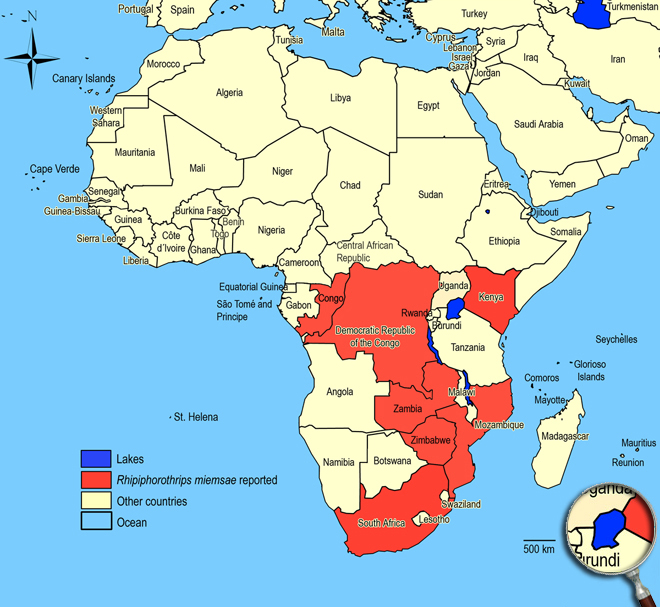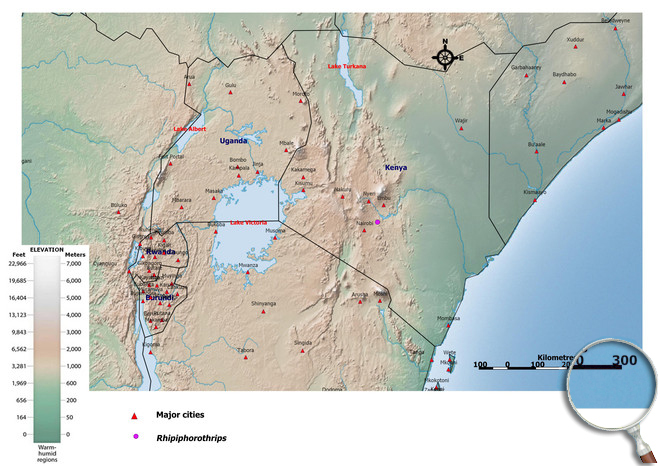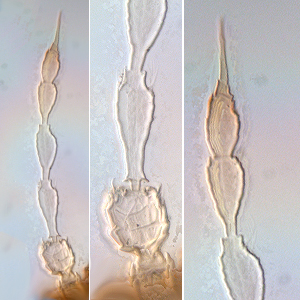Rhipiphorothrips miemsae Jacot-Guillarmod, 1937
Panchaetothripinae, Thripidae, Terebrantia, Thysanoptera
Figures
Fig. 1: 8-segmented antenna, pedicel and segment III, terminal segments V-VIII
Fig. 2: Head dorsal with ocellar triangle
Fig. 3: Pronotum
Fig. 4: Meso- and metanotum
Fig. 5: Metanotum and abdominal tergites I and II
Fig. 6: Fore wing, fore wing basal and distal region
Fig. 7: Tergites VII and VIII
Introduction and recognition
Rhipiphorothrips miemsae causes damage on native trees and shrubs like bushwillows (Combretum sp.) and yellow bitter-apple (Solanum panduriforme). Both sexes fully winged. Head, mesonotum, metascutum and sides of pterothorax brown; metascutellum, abdomen and legs yellow; antennal segments I-V and basal half of VI yellow, apical half of VI and VII & VIII brown; fore wings pale with yellow veins. Antennae 8-segmented; segments III & IV with forked sense cone on a stalked base, VIII more than twice as long as VII (Fig. 1). Head with complex irregular, rugose sculpture; cheeks sharply incut behind eyes and constricted to basal neck (Fig. 2). Pronotum rounded, covered by reticulations and with no long setae (Fig. 3). Mesonotum with complete longitudinal division (Fig. 4). Metanotal reticulate triangle well developed; 1 pair of minute setae near posterior, 1 pair of campaniform sensilla (Fig. 5). Mid and hind tarsi 1-segmented. Fore wing apex rounded with 2 slender cilia; fore wing first vein close to or fused to costal vein; anterior margin with no cilia, posteromarginal cilia straight; veinal setae minute (Fig. 6). Tergites III-VIII strongly sculptured laterally, with median groove of small reticles, and 1 pair of strong median setae (Fig. 7); setae on hind margin of tergites IX and X stout and expanded (fan-shaped at apex); X with complete longitudinal division. Sternal marginal setae minute.
Male similar to female; tergite IX with a pairs of posteromedian fan-shaped setae; sternites III-VII each with a small circular glandular area on anterior margin.
Taxonomic identity
Species
Rhipiphorothrips miemsae Jacot-Guillarmod, 1937
Taxonomic history
Rhipiphorothrips jacoti Priesner, 1939
Common name
-
Present taxonomic position
Family: Thripidae Stephens, 1829
Subfamily: Panchaetothripinae Bagnall, 1912
Genus: Rhipiphorothrips Morgan, 1913
Genus description
The genus Rhipiphorothrips Morgan, 1913
This genus includes 5 species, all from the Old World. The two African species have a forked sense cone on antennal segments III & IV, whereas these sense cones are simple in the two Oriental species. Furthermore one species known only from China (Zhang & Tong 1993). Members of the genus Rhipiphorothrips are remarkable amongst the Panchaetothripinae because of the curious irregular sculpture on the head. All of them have fore wings without fringe cilia on the anterior margin, and a complete longitudinal division on the mesonotum (Palmer et al. 1989).
Species description
Typical key character states of Rhipiphorothrips miemsae
Coloration and body sculpture
Body color: distinctively bicolored
Surface of head, pronotum and fore legs: with heavy, often polygonally reticulate sculpture
Sculptured reticles on head and pronotum: with no internal markings
Antennae
Form of sense cones on antennal segment III and IV: emergent and forked on segment III and IV
Number of antennal segments: 8
Terminal antennal segments: VI-VIII forming a single unit
Head
Cheeks shape: constricted to basal neck
Head - occipital ridge dorsally: absent
Head: distinctly prolonged in front of compound eyes
Ocelli: present
Prothorax
Pronotal blotch or internal apodeme: absent
Pronotum shape: broadly rectangular
Mesothorax
Mesonotum: with a complete longitudinal devision
Metathorax
Metanotum with dominant sculptured triangle medially: with weakly defined reticulate triangular area or dominant sculptured triangle medially
Shape of metathoracic furca: transverse, V-shaped
Wings
Fore and hind wings: present, more than half as long as abdomen (macropterous)
Fringe cilia arising: from sockets
Fore wing veins: present
Fore- and hind wing surface: covered with microtrichia
Apex of fore wing: with prominent terminal setae
Fore wing anterior margin (costal vein): without any long setae or long cilia
Fore wing costal fringe cilia: arising at anterior margin of wing
Fore wing first vein: close to or fused to costal vein
Fore wing first vein setal row: incomplete, with setae not closely and uniformly spaced
Fore wing second vein setal row: incomplete, with setae not closely and uniformly spaced
Fore wing shape: mainly parallel sided or margins run continuously towards each other
Fore wing surface: not reticulate
Fringe cilia on posterior margin near apex: straight
Length of fore wing costal setae at middle of wing: minute
Shape of fore wing apex: with continuous rounded margin or with mainly anterior margin curved to join posterior margin
Fore wing extreme apex color: dark (rare: pale)
Fore wings: uniformly pale or weakly shaded
Legs
Mid and hind tarsi: with one segment
Color of fore tarsi: pale or yellow, sometimes apical shaded or brown
Abdomen
Tergite II: without specialised cuticles laterally
Tergites IV and V median setal pair: longer than distance between their bases
Tergite VIII to X: without unusually long and stout setae
Tergites: without distinctive tergal sculpture forming a series of arches on the antecostal ridges
Tergite X: not tubular, longitudinally incomplete
Setae on abdominal tergite X: all setae slender

Similar or related species
Compared to other Panchaetothripinae, Rhipiphorothrips miemsae shows a strong irregular reticulate and rugose sculpture on the head and pronotum, and a complete longitudinal division medially on mesonotum. It is similar to Retithrips syriacus, Phibalothrips peringueyi and Heliothrips sylvanus, with all of them the anterior fringe cilia and long costal setae on the fore wings are missing, posterior fringe cilia straight, wings uniformly pale or light brown, and a dominant or weakly sculptured triangle medially on metanotum. Unlike Rhipiphorothrips miemsae and Retithrips syriacus, Phibalothrips peringueyi has 7-segmented antennae with simple sense cone on segments III & IV, whereas Rhipiphorothrips miemsae and Retithrips syriacus have 8-segmented antennae with forked sense cone on segments III & IV, and Heliothrips sylvanus has also 8-segmented antennae but with simple sense cone on segments III & IV. Retithrips syriacus differs from Rhipiphorothrips miemsae and other species in having polygonal reticles on the head and pronotum with distinct internal wrinkles, (others without), metathoracic furca elongate and Y-shaped (other species with V-shaped metathoracic furca), fore wings bearing anteromarginally 3 curious blister-like callosities, tergite VIII with a complete posteromarginal comb of long strong microtrichia, and minute setae on tergite X.
Biology
Life history
As with other thrips species the life cycle from egg to adult is dependent on temperature. The full cycle can take about 15 days to over a month and adults may live for more than one month producing several generations in one year depending on seasonal weather (Lewis 1973). With greenhouse temperatures the developmental time from egg to adult can decrease to about one week.
Host plants
Native trees and shrubs: banyan tree (Ficus indica), Brachystegia filiformis, bushwillows (Combretum sp.), wild rose, yellow bitter-apple (Solanum panduriforme).
Vector capacity
None identified, but possible mechanical distribution of phytopathogenic fungi and bacteria.
Damage and symptoms
-
Detection and control strategies
-
Additional notes
-

Biogeography
Africa. Congo (Eala), Mozambique, Kenya (Thika - Central Province), South Africa (Limpopo: Woodbush, Mokeetsi), Zambia,
Zimbabwe.
African countries where Rhipiphorothrips miemsae has been reported

Occurence of Rhipiphorothrips miemsae in East Africa

Please click here for survey sites of all observed thrips species of Kenya, Tanzania and Uganda.
Click here for locations of Rhipiphorothrips species in parts of East Africa.
Bibliography
Jacot-Guillarmod CF (1937). Ten new species of Thysanoptera and a catalogue of the known South African forms. Publications of the University of Pretoria, Serie 2, Natural Science. 3: 1-63
Lewis T (1973). Thrips: their biology, ecology and economic importance. Academic Press Inc., London Ltd., 349 pp
Moritz G (2006). Thripse. Pflanzensaftsaugende Insekten, Bd. 1, (1. Auflage). Westarp, Hohenwarsleben, 384 pp. ISBN-13: 978 3 89432 891 7
Moritz G, Morris DC & Mound LA (2001). ThripsID - Pest thrips of the world. ACIAR and CSIRO Publishing Collingwood, Victoria, Australia, CDROM ISBN 1 86320 296 X
Moritz G, Mound LA, Morris DC & Goldarazena A (2004). Pest thrips of the world - an identification and information system using molecular and microscopical methods. Centre for Biological Information Technology, University of Queensland, Australia, CDROM ISBN 1 86499 781 8
Moritz G, O'Donnell C & Parrella M (2009). Pest thrips of North America. Centre for Biological Information Technology, University of Queensland, Australia, CDROM ISBN-13: 978 1 86499 940 2
Mound LA & Kibby G (1998). Thysanoptera: An identification guide, (2nd edition). CAB International, Wallingford and New York, 70 pp
Nickle DA (2009). Commonly intercepted thrips at U.S. ports-of-entry from Africa, Europe, and the Mediterranean. IV. Miscellaneous thripine genera excluding Frankliniella, Iridothrips, and Thrips (Thysanoptera: Thripidae). Proceedings of the Entomological Society of Washington. 111 (1): 215-238
Palmer JM, Mound LA & du Heaume GJ (1989). 2. Thysanoptera, 73 pp. In Betts CR [ed.], CIE Guides to insects of importance to man. CAB International, Wallingford, Oxon, UK
Priesner H (1939). Thysanopteren aus dem Belgischen Congo (6. Beitrag). Revue de Zoologie et de Botanique Africaines. 32 (2): 154-175
Wilson TH (1975). A monograph of the subfamily Panchaetothripinae (Thysanoptera: Thripidae). Memoirs of the American Entomological Institute. 23: 1-354
Zhang W & Tong X (1993). Notes on some Panchaetothripinae species form Xishuangbanna, with description of a new species (Thripidae, Thysanoptera). Journal of the South China Agricultural University. 14 (2): 51-54
zur Strassen R (1960). Catalogue of the known species of South African Thysanoptera. Journal of the Entomological Society of Southern Africa. 23 (2): 321-367
----
Web links
Mound´s Thysanoptera pages
Thysanoptera Checklist
ICIPE Thrips survey sites
UNI Halle & Thrips sites
Thrips of California











